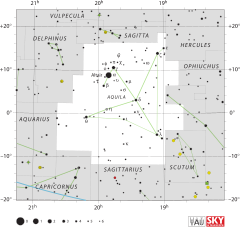Star in the constellation Aquila
Mu Aquilae
Observation dataEpoch J2000 Equinox J2000
Constellation
Aquila
Right ascension
19 34 05.3529
Declination
+07° 22′ 44.189″
Apparent magnitude (V)
4.45
Characteristics
Spectral type
K3-IIIb Fe0.5
U−B color index
+1.24
B−V color index
+1.176
R−I color index
0.61
Astrometry Radial velocity (Rv )−24.73±0.13 km/s Proper motion (μ) RA: +213.73 mas /yr Dec.: −156.55 mas /yr Parallax (π)30.31 ± 0.24 mas Distance 107.6 ± 0.9 ly pc ) Absolute magnitude (MV )1.80 Details Mass 1.16±0.10 M ☉ Radius 7.43±0.15 R ☉ Luminosity 24.5 L ☉ Surface gravity (log g )2.70±0.06 cgs Temperature 4,567±79 K Metallicity 0.16 dex Rotational velocity (v sin i )0.0 km/s Age 6.71±2.19 Gyr Other designations μ Aql , 38 Aql , BD +07 4132, FK5 1511, GJ 9661, HD 184406, HIP 96229, HR 7429, SAO 124799, LTT 15709 Database references SIMBAD data
Mu Aquilae , Latinized from μ Aquilae, is the Bayer designation for a single star in the equatorial constellation of Aquila . With an apparent visual magnitude of 4.45, it is visible to the naked eye. The measured annual parallax shift of this star is 30.31 mas , which gives a distance estimate of 107.6 light-years (33.0 parsecs ) from Earth. It is drifting closer with a radial velocity of −25 km/s, and displays a relatively high proper motion , traversing the celestial sphere at the rate of 0.264″ per year.
The stellar classification of Mu Aquilae is K3-IIIb Fe0.5, indicating that this is an evolved giant star with a mild overabundance of iron appearing in its spectrum . It belongs to a sub-category of giants called the red clump , which means it is generating energy through the fusion of helium at its core. Compared to the Sun, it has 116% of the mass and has expanded to 7.7 times the size. This inflated outer envelope has an effective temperature of 4,567 K and is radiating 24.5 times the Sun's luminosity. At this heat, Mu Aquilae glows with the orange hue of a K-type star . It is roughly seven billion years old.
References
^ van Leeuwen, F. (November 2007), "Validation of the new Hipparcos reduction", Astronomy and Astrophysics , 474 (2): 653–664, arXiv :0708.1752 , Bibcode :2007A&A...474..653V , doi :10.1051/0004-6361:20078357 , S2CID 18759600 .
^ Johnson, H. L.; et al. (1966), "UBVRIJKL photometry of the bright stars", Communications of the Lunar and Planetary Laboratory , 4 (99): 99, Bibcode :1966CoLPL...4...99J .
^ Keenan, Philip C.; McNeil, Raymond C. (1989), "The Perkins catalog of revised MK types for the cooler stars", The Astrophysical Journal Supplement Series , 71 : 245, Bibcode :1989ApJS...71..245K , doi :10.1086/191373 .
^ Massarotti, Alessandro; et al. (January 2008), "Rotational and Radial Velocities for a Sample of 761 HIPPARCOS Giants and the Role of Binarity", The Astronomical Journal , 135 (1): 209–231, Bibcode :2008AJ....135..209M , doi :10.1088/0004-6256/135/1/209 , S2CID 121883397 .
^ Hekker, S.; et al. (August 2006), "Precise radial velocities of giant stars. I. Stable stars", Astronomy and Astrophysics , 454 (3): 943–949, arXiv :astro-ph/0604502 , Bibcode :2006A&A...454..943H , doi :10.1051/0004-6361:20064946 , S2CID 119529768
^ Maldonado, J.; et al. (June 2013), "The metallicity signature of evolved stars with planets", Astronomy & Astrophysics , 554 : 18, arXiv :1303.3418 , Bibcode :2013A&A...554A..84M , doi :10.1051/0004-6361/201321082 , S2CID 119289111 , A84.
Baines, Ellyn K.; Clark, James H., III; Schmitt, Henrique R.; Stone, Jordan M.; von Braun, Kaspar (2023-12-01). "33 New Stellar Angular Diameters from the NPOI, and Nearly 180 NPOI Diameters as an Ensemble" . The Astronomical Journal . 166 (6): 268. Bibcode :2023AJ....166..268B . doi :10.3847/1538-3881/ad08be . ISSN 0004-6256 . {{cite journal }}: CS1 maint: multiple names: authors list (link )
"* mu. Aql" , SIMBAD Centre de données astronomiques de Strasbourg , retrieved 2012-07-18.Eggleton, Peter; Tokovinin, A. (2008), "A catalogue of multiplicity among bright stellar systems", Monthly Notices of the Royal Astronomical Society 389 (2): 869, arXiv :0806.2878 , Bibcode :2008MNRAS.389..869E , doi :10.1111/j.1365-2966.2008.13596.x , S2CID 14878976 .
Lépine, Sébastien; Shara, Michael M. (March 2005), "A Catalog of Northern Stars with Annual Proper Motions Larger than 0.15" (LSPM-NORTH Catalog)", The Astronomical Journal , 129 (3): 1483–1522, arXiv :astro-ph/0412070 , Bibcode :2005AJ....129.1483L , doi :10.1086/427854 , S2CID 2603568 .
Alves, David R. (August 2000), "K-Band Calibration of the Red Clump Luminosity", The Astrophysical Journal , 539 (2): 732–741, arXiv :astro-ph/0003329 , Bibcode :2000ApJ...539..732A , doi :10.1086/309278 , S2CID 16673121 .
"The Colour of Stars" , Australia Telescope, Outreach and Education , Commonwealth Scientific and Industrial Research Organisation , December 21, 2004, archived from the original on March 18, 2012, retrieved 2012-01-16.
External links
Categories :
Text is available under the Creative Commons Attribution-ShareAlike License. Additional terms may apply.
**DISCLAIMER** We are not affiliated with Wikipedia, and Cloudflare.
The information presented on this site is for general informational purposes only and does not constitute medical advice.
You should always have a personal consultation with a healthcare professional before making changes to your diet, medication, or exercise routine.
AI helps with the correspondence in our chat.
We participate in an affiliate program. If you buy something through a link, we may earn a commission 💕
↑
